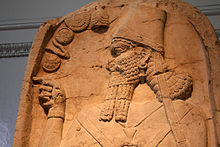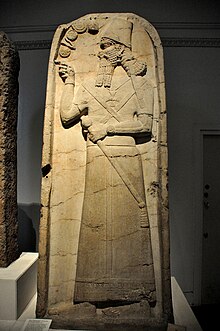Shamshi-Adad V
Shamshi-Adad V | |
|---|---|
 Detail from a stele portraying Shamshi-Adad V in British Museum | |
| Title | King of Assyria |
| Spouse | Shammuramat |
| Children | King Adad-nirari III |
| Parent | King Shalmaneser III |
Shamshi-Adad V was the King of Assyria from 824 to 811 BC. He was named after the god Adad, who is also known as Hadad.[1][2]
Family
Shamshi-Adad was a son and successor of King Shalmaneser III, the husband of Queen Shammuramat (by some identified with the mythical Semiramis), and the father of Adad-nirari III, who succeeded him as king.[3]
He was also a grandfather of Shalmaneser IV.[4][5]
Reign
The first years of Shamshi-Adad's reign saw a serious struggle for the succession of the aged Shalmaneser.

The revolt was led by Shamshi-Adad's brother Assur-danin-pal, and had broken out already by 826 BC. The rebellious brother, according to Shamshi-Adad's own inscriptions, succeeded in bringing to his side 27 important cities, including Nineveh. The rebellion lasted until 820 BC, weakening the Assyrian empire and its ruler; this weakness continued to reverberate in the kingdom until the reforms of Tiglath-Pileser III.
Later in his reign, Shamshi-Adad campaigned against Southern Mesopotamia, and stipulated a treaty with the Babylonian king Marduk-zakir-shumi I.
In 814 BCE, he won the Battle of Dur-Papsukkal against the Babylonian king Marduk-balassu-iqbi, and a few Aramean tribes settled in Babylonia.
See also
Notes
- ^ Reilly, Jim (2000) "Contestants for Syrian Domination" in "Chapter 3: Assyrian & Hittite Synchronisms" The Genealogy of Ashakhet;
- ^ Empires and Exploitation: The Neo-Assyrian Empire, P Bedford, WA Perth, 2001
- ^ Encyclopædia Britannica Eleventh Edition
- ^ Georges Roux: Ancient Iraq, Penguin Books, London 1992, ISBN 0-14-012523-X, p. 302.
- ^ Britannica.com
